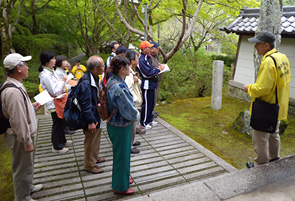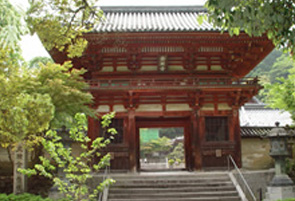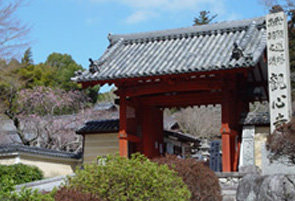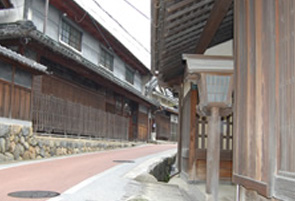HOME > The Kawachinagano Volunteer Guide Club:ENGLISH
The Kawachinagano Volunteer Guide Club


- The Kawachinagano Volunteer Guide Club members take visitors on tours around the town. The Kawachinagano Volunteer Guide Club was established in April 2003. The club has 60 registered members who work as volunteer guides on four main tour courses around Kawachinagano. Everyone is welcome! We are very happy to arrange a tour guide for you.
The Tour Courses Guide
- Kongoji Temple[天野山金剛寺]
 This temple is said to have been established by the holy priest Gyoki, who was born in Sakai, Osaka and who lived from 668 - 749 AD. The temple is also known by the names of "Nyonin Koya" (the place for women to train themselves) and "Amano Angu" (the Emperor’s temporary quarters for 6 years after 1354). Three generations of emperors at times resided there, so this temple has great historical significance. Kongoji Temple is particularly well known for its artistic treasures and buildings. The Temple and its precious contents have been officially designated by the Japanese government either as National Treasures or as Important Tangible Cultural Properties. The temple garden, constructed during the Muromachi Period, (1392 - 1573 AD), is particularly splendid, and is definitely worth seeing.
This temple is said to have been established by the holy priest Gyoki, who was born in Sakai, Osaka and who lived from 668 - 749 AD. The temple is also known by the names of "Nyonin Koya" (the place for women to train themselves) and "Amano Angu" (the Emperor’s temporary quarters for 6 years after 1354). Three generations of emperors at times resided there, so this temple has great historical significance. Kongoji Temple is particularly well known for its artistic treasures and buildings. The Temple and its precious contents have been officially designated by the Japanese government either as National Treasures or as Important Tangible Cultural Properties. The temple garden, constructed during the Muromachi Period, (1392 - 1573 AD), is particularly splendid, and is definitely worth seeing.
Formerly, this temple made sake, or Japanese wine, which was loved by warriors, especially Hideyoshi Toyotomi, (1537 – 1598 AD), who ruled during the Warring States Period, or the Sengoku Jidai. A religious ceremony or memorial service is held annually for Kobo Daishi, or “Saint Kobo", known during his lifetime as the great Buddhist priest, Kukai, (774 – 835 AD). He established a new Buddhist religious sect in Mt. Koya.
- Enmeiji Temple[延命寺]
 In the Heian Period (794 -1185 AD), Kukai, also known as Kobo Daishi, (774 – 835 AD), founded the Shingon or “True Word” school of Buddhism. He was a venerated Japanese monk, scholar-poet and artist; he went on pilgrimage to Enmei Temple.
In the Heian Period (794 -1185 AD), Kukai, also known as Kobo Daishi, (774 – 835 AD), founded the Shingon or “True Word” school of Buddhism. He was a venerated Japanese monk, scholar-poet and artist; he went on pilgrimage to Enmei Temple.
At Enmei Temple Kukai discovered a lot of medicinal trees and herbs. He also found natural spring water gushing out of the ground. He thought this special place would be good as the base for spreading his teaching, the Shingon Buddhist sect teachings. He made a Jizo Bodhisattva statue with his own hands and enshrined it as the principle deity. It had been neglected for a long time but is now well cared for. Later, in the Edo period (1603 -1867 AD ), Jyogon rebuilt this temple and renamed it Enmeiji Temple. base for spreading his teaching, the Shingon Buddhist sect teachings. He made a Jizo Bodhisattva statue with his own hands and enshrined it as the principle deity. It had been neglected for a long time but is now well cared for. Later, in the Edo period (1603 -1867 AD ), Jyogon rebuilt this temple and renamed it Enmeiji Temple.
- Kanshinji Buddhist Temple[観心寺]
 Kanshinji Temple was first known as Unshinji. It was built by Enno Ozunu in 701. It contains the famous statue called Nyoirin Kannon Bosatsu, or the statue of the Goddess of Mercy. This statue was made by the venerated monk Kobo Daishi in 1901 and was later declared a National Treasure by the Japanese government.Jichie, Kobo Daishi’s first disciple built a monastery on the temple grounds which was used over time as a resting station for pilgrims visiting the temple on their way to Koya Mountain from Kyoto.
Kanshinji Temple was first known as Unshinji. It was built by Enno Ozunu in 701. It contains the famous statue called Nyoirin Kannon Bosatsu, or the statue of the Goddess of Mercy. This statue was made by the venerated monk Kobo Daishi in 1901 and was later declared a National Treasure by the Japanese government.Jichie, Kobo Daishi’s first disciple built a monastery on the temple grounds which was used over time as a resting station for pilgrims visiting the temple on their way to Koya Mountain from Kyoto.
Kusunoki Masashige, a famous military commander from the Nanbokucho Period in the 14th century lived nearby and studied at this monastery as a child. During the 14th century, Japan was governed by two separate governments. One government, called Hokucho, was in the north, and the other, Nancho, was in the south. Kanshinji Temple was used by the southern, or Nancho government. At that time, temples were important buildings and had many other uses besides religious uses. Because of Kanshinji’s close association with the government many significant historical art objects and historical buildings were situated and maintained here, having been carefully preserved and handed down from one generation to the next.
One such building named Kondo built on the same grounds, is also a National Treasure. One of its significant characteristics is that it is influenced by two styles of architecture of the time: the Zen Buddhist and the traditional Japanese styles of architecture. There is another important cultural building on this property called the Nanko Tatekakenoto.Many worshipers come to Kanshinji every year to enjoy the beauty of each season. In spring, the plum and cherry blossoms are spectacular. In autumn, the colored leaves dominate the scenery; in winter, the snow glitters in the warm sunshine.
- Koya Kaido, or Historical Roads from Kyoto to Mt.Koya[高野街道]
 The Koya Kaido were the roads that linked the sacred Buddhist mountain, Mt. Koya (of the Shingon Buddhist Sect) with the ancient capital of Japan, Kyoto. In the Heian Period, (794 -1185 AD), the Koya Kaido (roads) were used by the Emperor and court noblemen; they were also used by samurai and common people since the Middle Ages.
The Koya Kaido were the roads that linked the sacred Buddhist mountain, Mt. Koya (of the Shingon Buddhist Sect) with the ancient capital of Japan, Kyoto. In the Heian Period, (794 -1185 AD), the Koya Kaido (roads) were used by the Emperor and court noblemen; they were also used by samurai and common people since the Middle Ages.
The Koya Roads were made up of, basically, three roads. These were the East Koya Road, the West Koya Road and the Middle Koya Road.
The East Koya Road, formerly known as the Nankaido, still runs today southward from Kyoto to Kawachinagano by way of Iwashimizu Hachiman, Horagatoge and the west side of Mt. Ikoma.The West Koya Road runs from Sakai to Kawachinagano. It begins at Oshoji in Sakai, branches off from the Takenouchi Road on the north of the Nintoku Mausoleum. It runs through Guminoki in Sayama and then joins the Middle Koya Road at Kusunokicho in Kawachinagano.
The Middle Koya Road runs straight from Hirano and it goes up to Sayama via Matsubara city, Miharacho, and joins the West Koya Road at Kawachinagano.It is believed that there was a fourth road, called the Lower Koya Road which ran straight from Shitennoji to Sayama where it joined the West Koya Road. Further details about this road are unknown. All three of the roads, the East Road, the West Road and the Middle Road finally meet at Kawachinagano City. The West Koya Road and the Middle Koya Road come together at Kusunokicho in Kawachinagano City. The West Koya Road and East Koya Road come together at the Kawachinagano Station square. Then finally, all become one road that run from Kawachinagano to Kimitoge and Mt.Koya.
- Takihata Viallge [奥河内 滝畑]
 In 1979 the multipurpose dam of Takihata was completed in the secret place “Takihata viallge”. It used to be a long journey, but now it only takes 30 minutes by the community.
In 1979 the multipurpose dam of Takihata was completed in the secret place “Takihata viallge”. It used to be a long journey, but now it only takes 30 minutes by the community.
All of the people in Takihata village are now trying to improve the situation of depopulation and aging, keeping the good old tradition, and trying to make “Takihata Village” a better place.
Three places in Takihata have been selected as the best scenic spots in Kawachinagano;
in autumn, “the Japanese pampas grass in Mt. Iwawaki”, in winter, “the mandarin ducks in the Takihata Dam and the Takihata 48 Falls.
Because Takihata is a mountain village blessed with natural beauty, lots of people come to enjoy the scenery of the falls, as well as playing in the river, barbecuing and living outdoor life.
Application
- Please apply for a tour and send a fax to
- 0721-26-7353
- NAME:
TELEHONE: (mobile or home)
Mail address:
The date and time you intend to arrive:
The numbers of people who want to take the tour:
Nationality:
Other information:






















